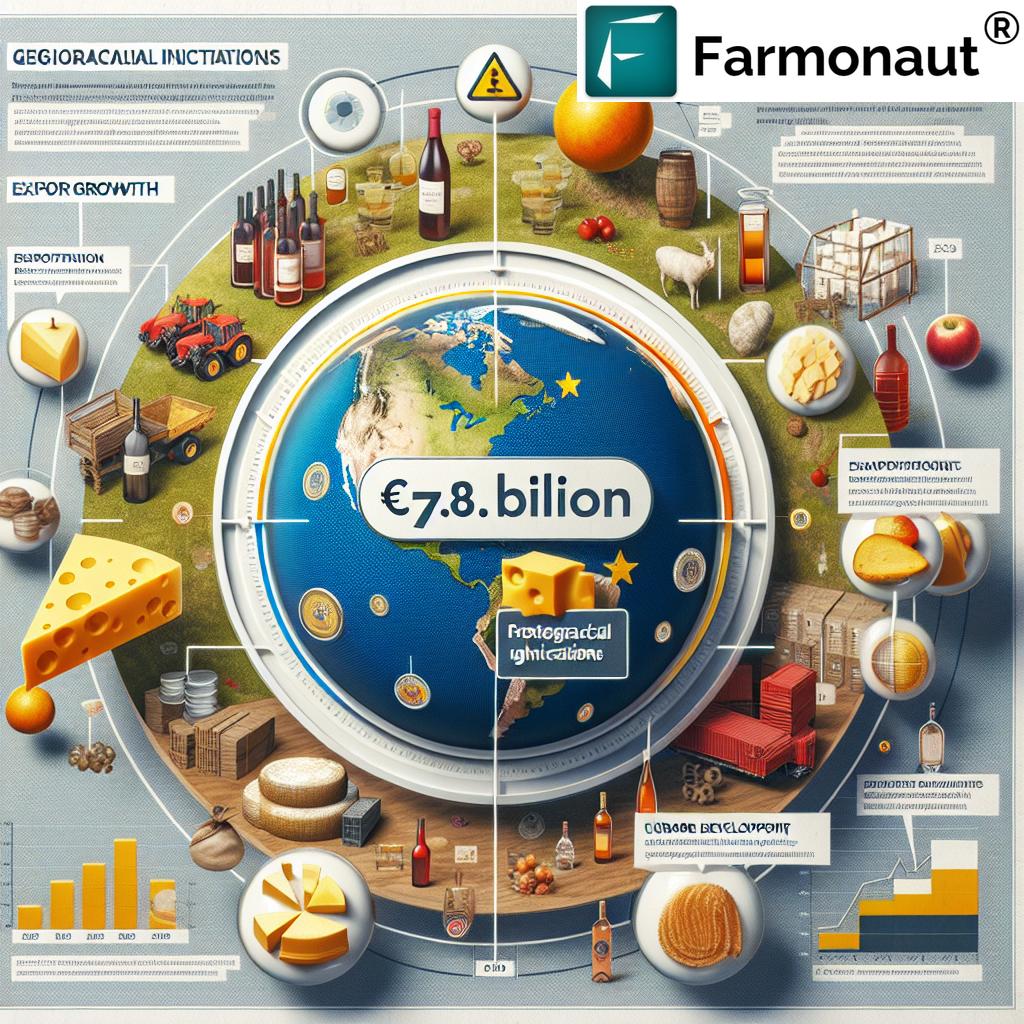EU-Mexico Agreement Boosts Protection for 600 Geographical Indications: A Milestone for Global Agricultural Trade
“The EU-Mexico agreement protects 600 geographical indications, boosting recognition for unique agricultural products.”
In the ever-evolving landscape of global agricultural trade, we are witnessing a significant milestone that promises to reshape the way we perceive and protect traditional food products. The recent enhancement of cooperation between the European Union (EU) and Mexico has brought geographical indications in agriculture to the forefront of international trade discussions. This blog post delves into the intricacies of the updated EU-Mexico agricultural agreement, exploring its far-reaching implications for agri-food exports, traditional farming practices, and rural development initiatives.
As we navigate through this comprehensive analysis, we’ll uncover the economic significance of these protected designations, examine the delicate balance between preserving culinary heritage and embracing agricultural innovation, and consider the potential impact on global agricultural partnerships. Join us as we explore how this landmark agreement is set to influence the future of sustainable farming recognition and agritech trade policies on a global scale.

Understanding Geographical Indications in Agriculture
Before we delve into the specifics of the EU-Mexico agreement, it’s crucial to understand what geographical indications (GIs) are and why they matter in the context of agriculture and global trade.
- Definition: Geographical indications are signs used on products that have a specific geographical origin and possess qualities or a reputation that are due to that origin.
- Purpose: GIs serve to protect the unique characteristics of products tied to their place of origin, preserving traditional knowledge and production methods.
- Examples: Well-known GIs include Champagne sparkling wine from France, Parmigiano-Reggiano cheese from Italy, and Tequila spirit from Mexico.
The protection of GIs is not just about safeguarding names; it’s about preserving cultural heritage, supporting rural economies, and ensuring consumer trust in the authenticity and quality of products. In the context of the EU-Mexico agreement, this protection takes on a new level of significance, encompassing a wide range of agricultural products and spirits.
The EU-Mexico Agreement: A Closer Look
The recent updates to the EU-Mexico agreement mark a significant step forward in bilateral cooperation on protected designations of origin for spirits and foodstuffs. Let’s break down the key aspects of this agreement:
- Scope: The agreement covers 600 geographical indications, offering unprecedented protection for a vast array of traditional products from both regions.
- Reciprocity: Both the EU and Mexico have committed to protecting each other’s GIs, fostering a mutually beneficial trade relationship.
- Product Categories: The protection extends to various product categories, including wines, spirits, cheeses, meats, and other agricultural products.
- Legal Framework: The agreement establishes a robust legal framework for the protection and enforcement of GIs in both markets.
This comprehensive approach to GI protection represents a milestone in international trade relations, setting a new standard for how countries can collaborate to preserve and promote their unique agricultural heritage.
Economic Impact of Geographical Indications
“The EU market for geographical indications is valued at €74.8 billion, highlighting their economic significance in agriculture.”
The economic implications of geographical indications are substantial, particularly for the European Union. With the EU market for GIs valued at an impressive €74.8 billion, it’s clear that these protected designations play a crucial role in the agricultural economy. Let’s explore the economic dimensions of GIs in more detail:
- Premium Pricing: Products with protected GIs often command higher prices in the market, reflecting their unique qualities and reputation.
- Export Value: GI products contribute significantly to agri-food exports, enhancing the international competitiveness of both EU and Mexican products.
- Rural Development: The protection of GIs supports rural economies by preserving traditional production methods and creating employment opportunities in specific regions.
- Market Differentiation: GIs help producers differentiate their products in a crowded marketplace, providing a competitive edge based on origin and quality.
The EU-Mexico agreement is expected to further boost the economic potential of GIs by opening up new markets and strengthening consumer recognition of these premium products.

Protecting Traditional Agricultural Practices
One of the most significant aspects of the EU-Mexico agreement is its role in preserving and promoting traditional agricultural practices. By protecting geographical indications, the agreement helps to:
- Preserve Heritage: Safeguard centuries-old production methods and recipes that are integral to cultural identity.
- Encourage Sustainability: Many traditional practices are inherently sustainable, aligning with modern environmental concerns.
- Support Biodiversity: Protect local plant varieties and animal breeds that are essential to specific GI products.
- Maintain Quality Standards: Ensure that products meet rigorous quality criteria associated with their geographical origin.
By recognizing and protecting these traditional practices, the agreement not only preserves cultural heritage but also contributes to the diversity and richness of global food culture.
Impact on Rural Development Initiatives
The protection of geographical indications has profound implications for rural development. Here’s how the EU-Mexico agreement is expected to boost rural economies:
- Job Creation: GI protection can lead to increased demand for local products, creating employment opportunities in rural areas.
- Tourism Boost: Protected products often become tourist attractions, driving visitors to rural regions and stimulating local economies.
- Knowledge Transfer: The agreement encourages the preservation and sharing of traditional knowledge between generations.
- Investment in Infrastructure: Increased recognition of GI products can lead to improved infrastructure in rural areas to support production and distribution.
These rural development initiatives are crucial for maintaining vibrant agricultural communities and preventing rural exodus, a challenge faced by many regions worldwide.
Global Agricultural Partnerships and Trade Policies
The EU-Mexico agreement on geographical indications is more than a bilateral arrangement; it sets a precedent for global agricultural partnerships and trade policies. Here’s how this agreement influences the broader international context:
- Model for Future Agreements: The comprehensive nature of this agreement could serve as a template for similar arrangements between other countries or regions.
- Harmonization of Standards: By aligning protection standards, the agreement contributes to a more unified global approach to GI recognition.
- Trade Facilitation: Clear rules on GI protection can reduce trade barriers and simplify export processes for protected products.
- Consumer Trust: Enhanced protection measures increase consumer confidence in the authenticity and quality of GI products in international markets.
As we consider the global implications, it’s worth noting how technologies like those offered by Farmonaut can play a role in supporting the implementation and monitoring of such agreements. Farmonaut’s satellite-based crop monitoring and AI-driven advisory systems can help ensure that GI products meet the required standards and sustainability criteria.
Agritech Innovations and GI Protection
While the EU-Mexico agreement focuses on protecting traditional products, it’s important to consider how modern agritech innovations can complement and enhance GI protection efforts. Technologies like those developed by Farmonaut can contribute to the sustainable production and verification of GI products:
- Precision Agriculture: Satellite-based monitoring can help maintain the quality and consistency of GI products by optimizing crop management practices.
- Weather Monitoring: Advanced weather forecasting tools can assist producers in adapting to climate challenges that may affect GI product quality.
- Irrigation Management: Smart irrigation systems can ensure that GI products receive optimal water levels, preserving their unique characteristics.
- Pest and Disease Control: AI-driven pest detection can help protect GI crops while minimizing the use of pesticides, aligning with sustainability goals.
The integration of these technologies with traditional practices demonstrates how innovation can support and enhance the production of geographically protected products.
For those interested in exploring how satellite technology can support agricultural practices, including those related to GI products, Farmonaut’s web application offers valuable insights:
Challenges and Opportunities
While the EU-Mexico agreement presents numerous benefits, it also comes with its share of challenges and opportunities:
Challenges:
- Implementation: Ensuring effective enforcement of GI protection across diverse markets and regulatory environments.
- Market Access: Balancing GI protection with fair market access for non-GI products.
- Consumer Education: Raising awareness about the value and meaning of GI labels among consumers.
- Adaptation to Climate Change: Maintaining GI product characteristics in the face of changing environmental conditions.
Opportunities:
- Innovation in Traditional Practices: Encouraging the development of new products that qualify for GI protection.
- Digital Traceability: Leveraging blockchain and other technologies to enhance the transparency and authenticity of GI products.
- Sustainable Agriculture: Using GI protection as a driver for more sustainable and environmentally friendly farming practices.
- Cultural Exchange: Promoting cross-cultural appreciation through the exchange of traditional food products.
Addressing these challenges and capitalizing on the opportunities will be crucial for maximizing the benefits of the EU-Mexico agreement and similar future arrangements.
The Role of Technology in Supporting GI Protection
As we consider the future of geographical indications and their protection, it’s clear that technology will play an increasingly important role. Platforms like Farmonaut offer tools that can support the production and verification of GI products:
- Satellite Monitoring: Regular satellite imagery can help verify that GI products are being grown in their designated areas and under the right conditions.
- Data Analytics: Advanced analytics can provide insights into crop health and yield predictions, ensuring the consistent quality of GI products.
- Mobile Applications: Easy-to-use mobile apps can help farmers and producers adhere to GI specifications and best practices.
For those interested in exploring how these technologies can be applied to their agricultural practices, Farmonaut offers both Android and iOS applications:
Comparative Analysis of Geographical Indications in the EU-Mexico Agreement
To better understand the scope and impact of the EU-Mexico agreement on geographical indications, let’s examine a comparative analysis of the protected products:
| Product Category | Number of GIs Protected (EU) | Number of GIs Protected (Mexico) | Estimated Economic Value (€ millions) | Key Benefits for Producers | Impact on Rural Development |
|---|---|---|---|---|---|
| Spirits | 80 | 20 | 15,000 | Premium pricing, export opportunities | Job creation, tourism boost |
| Cheeses | 180 | 10 | 9,000 | Brand protection, market differentiation | Preservation of traditional methods |
| Meats | 120 | 15 | 7,500 | Quality assurance, consumer trust | Support for local livestock farming |
| Fruits and Vegetables | 100 | 25 | 5,000 | Recognition of unique varieties | Biodiversity conservation |
| Olive Oils | 40 | 5 | 3,000 | Protection against imitation | Sustainable agricultural practices |
This table illustrates the comprehensive nature of the EU-Mexico agreement, covering a wide range of product categories with significant economic value. It’s clear that the protection of geographical indications has far-reaching implications for both producers and rural communities.
The Future of Geographical Indications and Global Trade
As we look to the future, the EU-Mexico agreement on geographical indications sets a precedent for how countries can collaborate to protect their agricultural heritage while fostering international trade. Here are some key trends and predictions:
- Expansion of GI Protection: We can expect to see more countries and regions seeking similar agreements to protect their unique products.
- Technology Integration: The use of advanced technologies like blockchain for traceability and satellite monitoring for compliance will likely increase.
- Consumer Awareness: As GI products gain more visibility, consumer education about their value and significance will become increasingly important.
- Sustainability Focus: GI protection may increasingly be linked to sustainable and environmentally friendly production methods.
- Global Standards: There may be efforts to establish more unified global standards for GI recognition and protection.
The role of technology in supporting these trends cannot be overstated. For instance, Farmonaut’s API and developer documentation offer resources for integrating advanced agricultural monitoring into existing systems, potentially aiding in the verification and management of GI products.
Conclusion: A New Era for Agricultural Heritage and Innovation
The EU-Mexico agreement on geographical indications marks a significant milestone in the protection of traditional agricultural products and the promotion of global agricultural trade. By safeguarding 600 unique products, this agreement not only preserves cultural heritage but also opens up new economic opportunities for rural communities and producers on both sides of the Atlantic.
As we’ve explored, the implications of this agreement extend far beyond simple name protection. It represents a commitment to quality, tradition, and sustainable agricultural practices. At the same time, it demonstrates how modern technologies and innovative approaches can complement and enhance the production and protection of traditional products.
The future of geographical indications in agriculture looks promising, with potential for further global cooperation, technological integration, and a continued focus on sustainability. As consumers become more discerning and interested in the provenance of their food and drink, the value of GI products is likely to grow even further.
For those involved in agriculture, whether as producers, policymakers, or technology providers, staying informed about developments in GI protection and leveraging tools like those offered by Farmonaut can help navigate this evolving landscape. By embracing both tradition and innovation, we can ensure that the rich tapestry of global agricultural heritage continues to thrive in an increasingly interconnected world.
Frequently Asked Questions (FAQ)
- What is a geographical indication (GI)?
A geographical indication is a sign used on products that have a specific geographical origin and possess qualities or a reputation that are due to that origin. - How many geographical indications are protected under the EU-Mexico agreement?
The agreement protects 600 geographical indications from both the EU and Mexico. - What types of products are covered by geographical indications?
GIs can cover a wide range of products, including wines, spirits, cheeses, meats, fruits, vegetables, and other agricultural products. - How do geographical indications benefit producers?
GIs offer premium pricing, protect against imitation, provide market differentiation, and help maintain traditional production methods. - What is the economic value of geographical indications in the EU?
The EU market for geographical indications is valued at €74.8 billion. - How do geographical indications contribute to rural development?
GIs support job creation, boost tourism, preserve traditional knowledge, and encourage investment in rural infrastructure. - Can technology play a role in protecting geographical indications?
Yes, technologies like satellite monitoring, blockchain for traceability, and precision agriculture tools can support the production and verification of GI products. - What challenges do geographical indications face?
Challenges include effective enforcement, balancing protection with market access, consumer education, and adapting to climate change. - How might the EU-Mexico agreement influence future trade agreements?
The comprehensive nature of this agreement could serve as a model for similar arrangements between other countries or regions. - What is the future outlook for geographical indications in global trade?
We can expect to see an expansion of GI protection, increased use of technology in verification, greater consumer awareness, and a focus on linking GIs with sustainable practices.
















